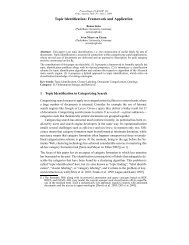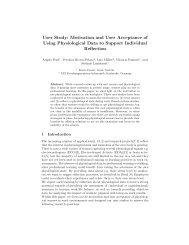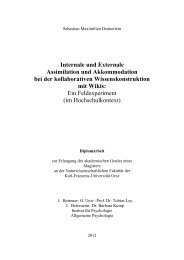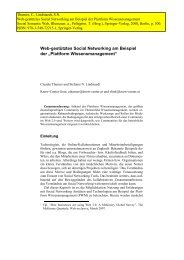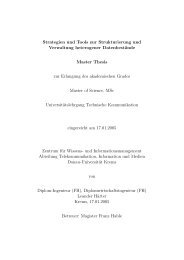Fostering adoption, acceptance and assimilation in ... - KnowMiner
Fostering adoption, acceptance and assimilation in ... - KnowMiner
Fostering adoption, acceptance and assimilation in ... - KnowMiner
Create successful ePaper yourself
Turn your PDF publications into a flip-book with our unique Google optimized e-Paper software.
KMS. In order to <strong>in</strong>crease <strong>acceptance</strong> on the <strong>in</strong>dividual level, the<br />
factor Facilitat<strong>in</strong>g Conditions <strong>in</strong> the group Effort Expectancy,<br />
describ<strong>in</strong>g the degree of provided organizational <strong>and</strong> technical<br />
<strong>in</strong>frastructure which supports system use [23], was used to<br />
formulate a recommendation for this application area. User<br />
support, expressed by tra<strong>in</strong><strong>in</strong>gs, tutorials, step-by-step guides,<br />
videos, <strong>and</strong> wikis were planned to be available <strong>and</strong> communicated<br />
<strong>in</strong> a proper way.<br />
5. LIMITATIONS<br />
The current research comb<strong>in</strong>es factors taken from several models<br />
<strong>and</strong> theories expla<strong>in</strong><strong>in</strong>g human behavior us<strong>in</strong>g IT on an <strong>in</strong>dividual<br />
as well as an organizational level <strong>in</strong>to one comprehensive model<br />
cover<strong>in</strong>g <strong>adoption</strong>, <strong>acceptance</strong> <strong>and</strong> <strong>assimilation</strong> of KMS.<br />
Consequently, validity is challeng<strong>in</strong>g <strong>in</strong> design <strong>and</strong> a complete<br />
validation is problematic <strong>and</strong> probably not feasible due to the<br />
large number of variables that would need to be controlled over a<br />
period of time due to the fact that <strong>adoption</strong>, <strong>acceptance</strong> <strong>and</strong><br />
<strong>assimilation</strong> are regarded as a process tak<strong>in</strong>g place <strong>in</strong> a dynamic<br />
socio-technical environment. However, all s<strong>in</strong>gle models <strong>and</strong><br />
theories used to extract factors, were <strong>in</strong>dividually validated<br />
As the model is <strong>in</strong>tended to be used to <strong>in</strong>form design activities,<br />
empirical validation of the model is not our primary concern, but<br />
we rather long for demonstrat<strong>in</strong>g its usefulness <strong>and</strong> practicability<br />
as an explicit guide that helps <strong>in</strong>vestigat<strong>in</strong>g <strong>and</strong> adjust<strong>in</strong>g design<br />
activities <strong>in</strong> respect to the <strong>adoption</strong>, <strong>acceptance</strong> <strong>and</strong> <strong>assimilation</strong><br />
by critically exam<strong>in</strong><strong>in</strong>g the s<strong>in</strong>gle factors for each phase <strong>in</strong> the<br />
context of the project. Such an application was demonstrated <strong>in</strong><br />
the case example above, i.e. a large scale project <strong>in</strong> which this<br />
approach was welcomed <strong>and</strong> resulted <strong>in</strong> a number of<br />
recommendations <strong>in</strong>form<strong>in</strong>g project decisions. The proposed<br />
categorization of factors <strong>and</strong> the dist<strong>in</strong>ction whether they can be<br />
<strong>in</strong>fluenced by KMS design or not is therefore argued for on the<br />
basis of a first application with<strong>in</strong> a large-scale R&D project <strong>in</strong> the<br />
field of KMS with multiple <strong>in</strong>stantiations for several dist<strong>in</strong>ct<br />
organizations.<br />
6. CONCLUSION AND OUTLOOK<br />
To conclude, the proposed model represents a comprehensive<br />
basis for a systematic consideration of factors <strong>in</strong>fluenc<strong>in</strong>g<br />
<strong>adoption</strong>, <strong>acceptance</strong> <strong>and</strong> <strong>assimilation</strong> with<strong>in</strong> the field of KM. Our<br />
contribution comprises a structured review of the literature, the<br />
consolidation of factors, selected as relevant for design<strong>in</strong>g KMS<br />
for the three topics <strong>adoption</strong>, <strong>acceptance</strong>, <strong>and</strong> <strong>assimilation</strong> as well<br />
as an example application of the model <strong>in</strong> a large-scale KMS<br />
project. Moreover, we differentiated between factors that can be<br />
<strong>in</strong>fluenced by design <strong>and</strong> those that cannot be <strong>in</strong>fluenced by<br />
design. As described <strong>and</strong> demonstrated, there are various<br />
applications <strong>in</strong> KMS design, e.g., evaluat<strong>in</strong>g (non-)functional<br />
requirements, elicit<strong>in</strong>g additional requirements, or <strong>in</strong>fluenc<strong>in</strong>g<br />
packag<strong>in</strong>g <strong>and</strong> offer<strong>in</strong>g of KMS <strong>in</strong> order to enhance the <strong>adoption</strong><br />
by organizations, the <strong>acceptance</strong> by users <strong>and</strong> the <strong>assimilation</strong> of a<br />
KMS solution <strong>in</strong>to organizational processes <strong>and</strong> work practices.<br />
Consequently, the model supports <strong>and</strong> <strong>in</strong>forms KMS design with<br />
the aim to improve the take-up of the result<strong>in</strong>g KMS solution.<br />
There are a number of future research directions <strong>and</strong> opportunities<br />
implied by the results of this paper. One is that the categories<br />
with<strong>in</strong> the model should be reviewed <strong>in</strong> the context of further<br />
applications. Moreover, additional applications <strong>and</strong> project<br />
experiences with the model may also allow a more detailed<br />
evaluation of the relevance of the factors specifically for KMS<br />
design. Besides that, it would be <strong>in</strong>terest<strong>in</strong>g to exam<strong>in</strong>e additional<br />
factors proposed <strong>in</strong> KM literature that are particularly important to<br />
improve the <strong>adoption</strong>, <strong>acceptance</strong> <strong>and</strong> <strong>assimilation</strong> of KMS.<br />
However, they are typically not validated upon strong empirical<br />
basis <strong>in</strong> contrast to most of the factors extracted for our model.<br />
Furthermore, we see other possible areas of application that are<br />
worth to be exam<strong>in</strong>ed, e.g., the use of the comprehensive model<br />
from the perspective of organizations that aim to adopt <strong>and</strong><br />
<strong>in</strong>troduce a KMS with<strong>in</strong> their organization. Factors that cannot be<br />
<strong>in</strong>fluenced by KMS design are suggested to be considered from an<br />
organizational perspective, e.g., the users’ attitude towards<br />
technology can be <strong>in</strong>fluenced by guidance, motivation or tra<strong>in</strong><strong>in</strong>gs<br />
when roll<strong>in</strong>g-out the KMS.<br />
7. ACKNOWLEDGMENTS<br />
This work was co-funded by the European Commission under the<br />
Information <strong>and</strong> Communication Technologies theme of the 7th<br />
Framework Programme, Integrat<strong>in</strong>g Project ARISTOTELE<br />
(contract no. FP7-257886).<br />
8. REFERENCES<br />
[1] Bishop, J., Bouchlaghem, D., Glass, J., <strong>and</strong> Matsumoto, I.<br />
2008. Ensur<strong>in</strong>g the effectiveness of a knowledge<br />
management <strong>in</strong>itiative. Journal of Knowledge Management.<br />
12, 4 (Nov. 2008), 16-29.<br />
[2] K<strong>in</strong>g, W. <strong>and</strong> Marksjr, P. 2008. Motivat<strong>in</strong>g knowledge<br />
shar<strong>in</strong>g through a knowledge management system.<br />
Omega.36, 1 (Feb. 2008), pp. 131-146.<br />
[3] Chatterjee, D., Grewal, R. <strong>and</strong> Sambamurthy, V. 2008.<br />
Shap<strong>in</strong>g up for E-Commerce: Institutional Enablers of the<br />
Organizational Assimilation of Web Technologies.<br />
Management Information Systems Quaterly. 26, 2 (Jun.<br />
2002), 65-89.<br />
[4] Rogers, E. 1995. Diffusion of Innovations. Free Press, New<br />
York.<br />
[5] Dillon, A. <strong>and</strong> Morris, M. 1996. User <strong>acceptance</strong> of new<br />
<strong>in</strong>formation technology - theories <strong>and</strong> models. In Annual<br />
Review of Information Science <strong>and</strong> Technology. M. Williams<br />
ed. 31, 3-32. Information Today, Medford, NJ.<br />
[6] Venkatesh, V., Morris, M., Davis, G.B., <strong>and</strong> Davis, F.D.<br />
2003. User <strong>acceptance</strong> of <strong>in</strong>formation technology: Towards a<br />
unified view. In MIS Quarterly. 27, 3 (Sep. 2003), 425-478.<br />
[7] Tornatzky, L.G. <strong>and</strong> Fleischer, M. 1990. The Processes of<br />
Technological Innovation. D.C. Heath & Company,<br />
Lex<strong>in</strong>gton, MA.<br />
[8] Chau, P.Y.K. 2001. Information Technology Acceptance by<br />
Individual Professionals: A Model Comparison Approach.<br />
Decision Sciences. 27, 3 (Dec. 2001), 451-719.<br />
[9] Zhu, K., Kraemer, K., <strong>and</strong> Xu, S. 2003. Electronic bus<strong>in</strong>ess<br />
<strong>adoption</strong> by European firms: a cross-country assessment of<br />
the facilitators <strong>and</strong> <strong>in</strong>hibitors. European Journal of<br />
Information Systems. 12, 4 (Dec. 2003), 251-268.<br />
[10] Mustonen-Ollila, E. <strong>and</strong> Lyyt<strong>in</strong>en, K. 2003. Why<br />
organizations adopt <strong>in</strong>formation system process <strong>in</strong>novations:<br />
a longitud<strong>in</strong>al study us<strong>in</strong>g Diffusion of Innovation theory.<br />
Information Systems Journal. 13, 3 (Jul. 2003), 275-297.<br />
[11] Teo, H.-H., Tan, B., <strong>and</strong> Wei, K.-K. 1995. Innovation<br />
diffusion theory as a predictor of <strong>adoption</strong> <strong>in</strong>tention for<br />
f<strong>in</strong>ancial EDI. In Proceed<strong>in</strong>gs of the Sixteenth International<br />
Conference on Information Systems (Amsterdam, The<br />
Netherl<strong>and</strong>s, December 10-13, 1995). ICIS 1995. ACM, New<br />
York, NY, 155-165.




